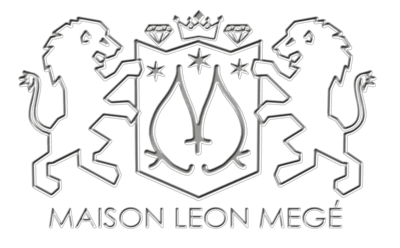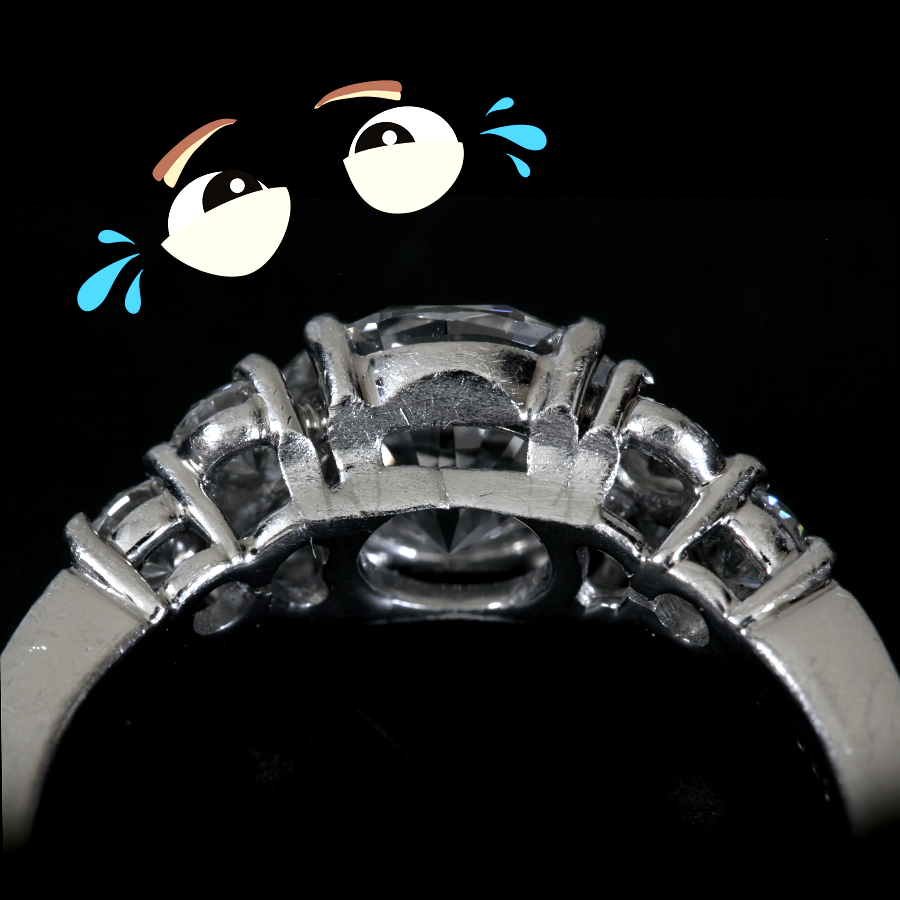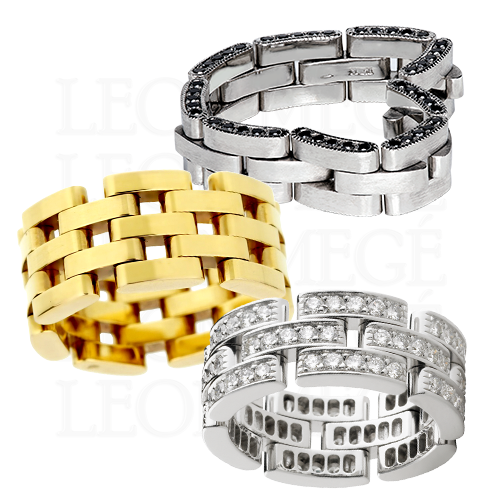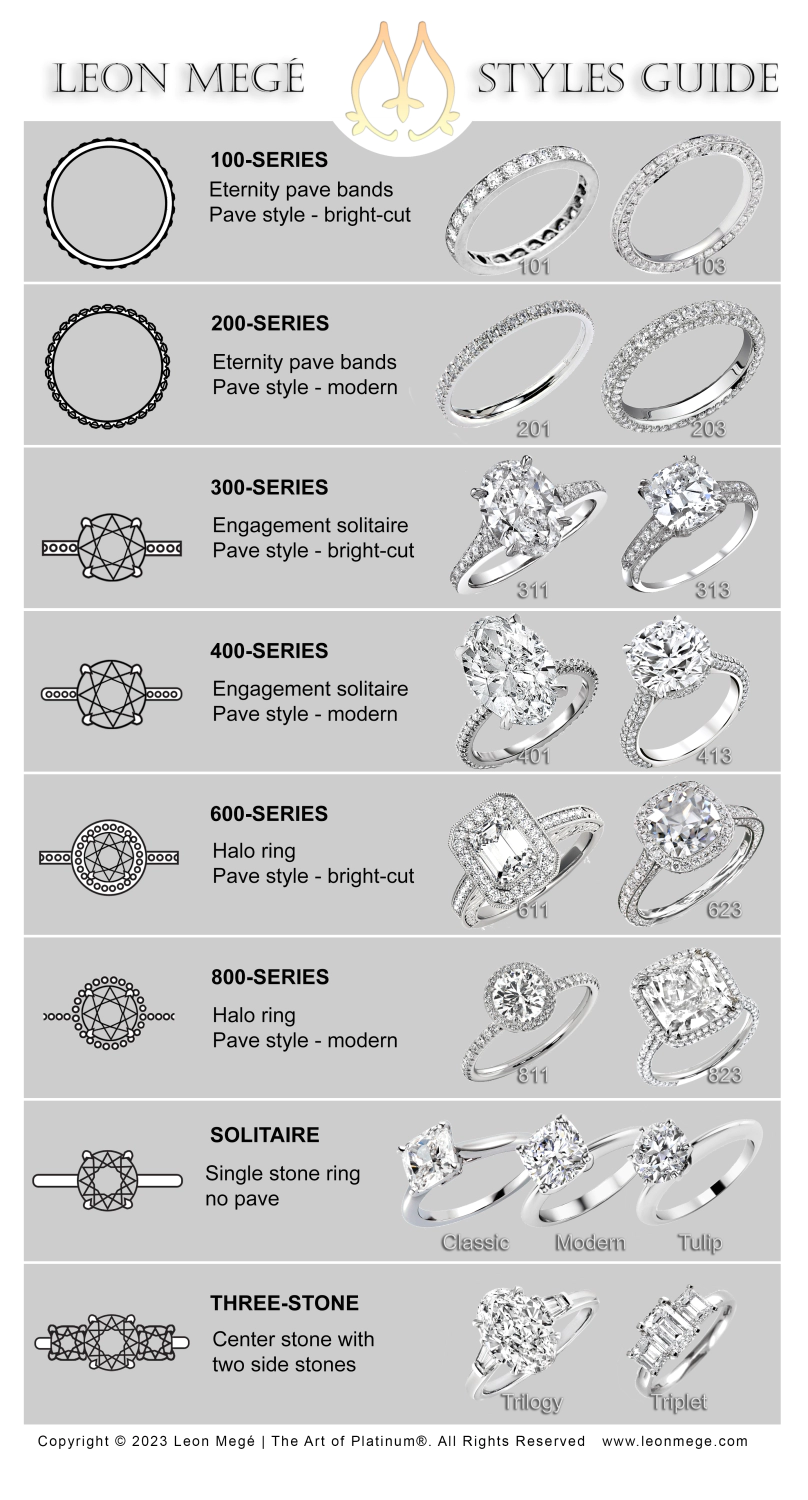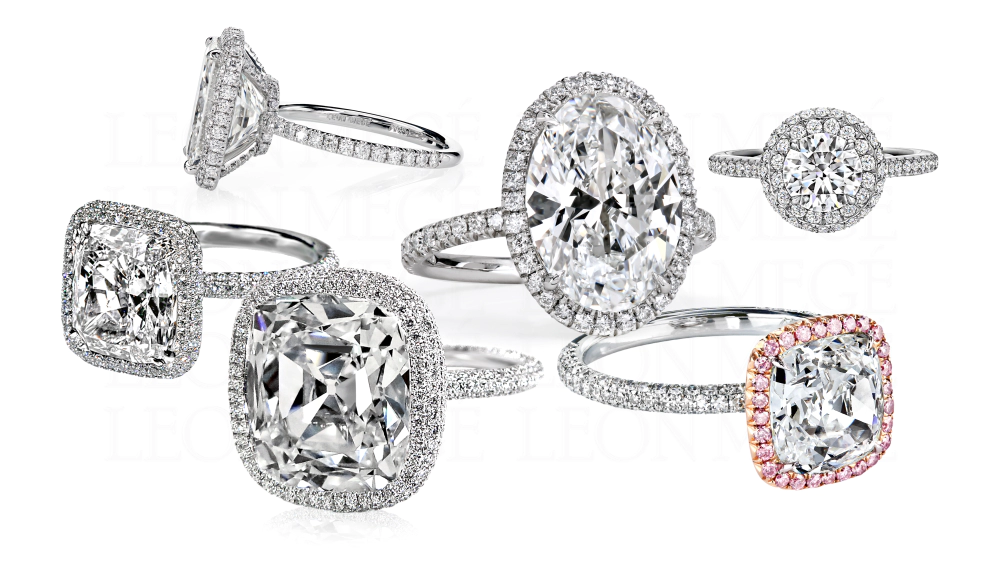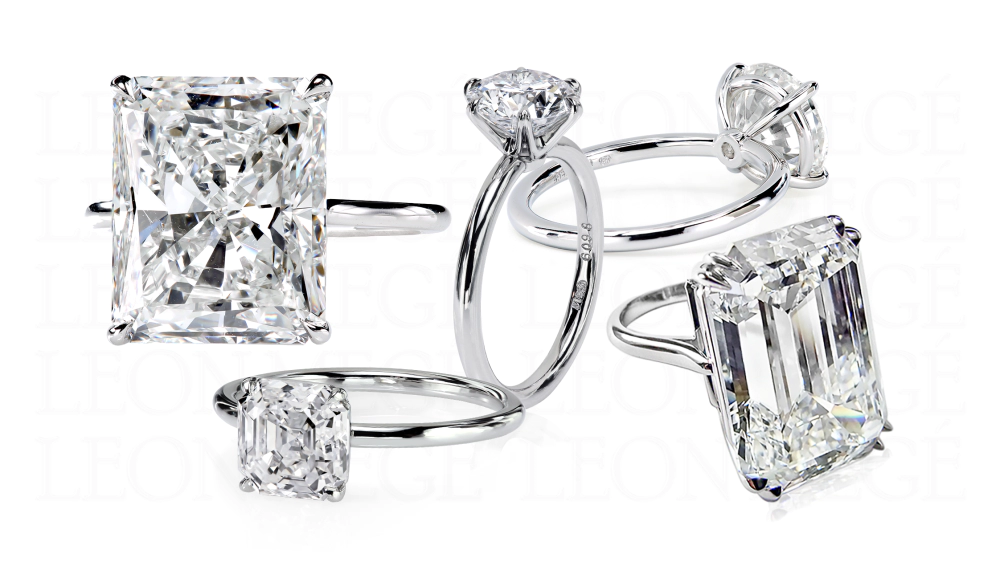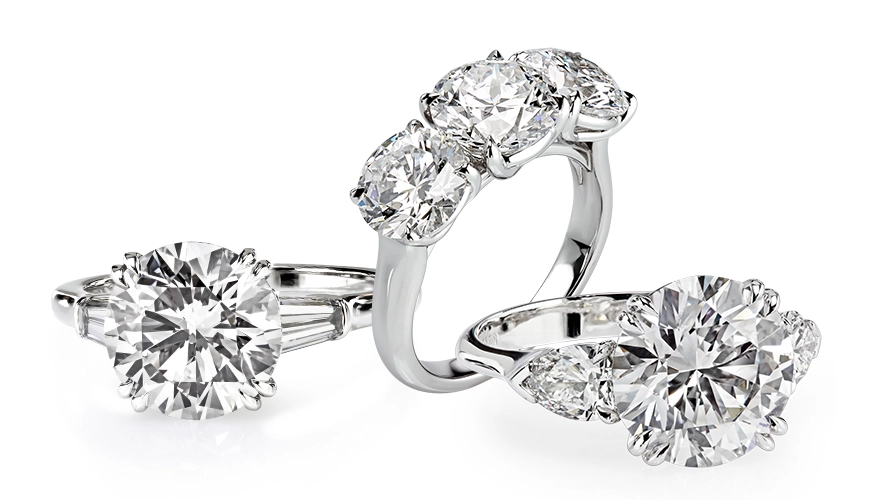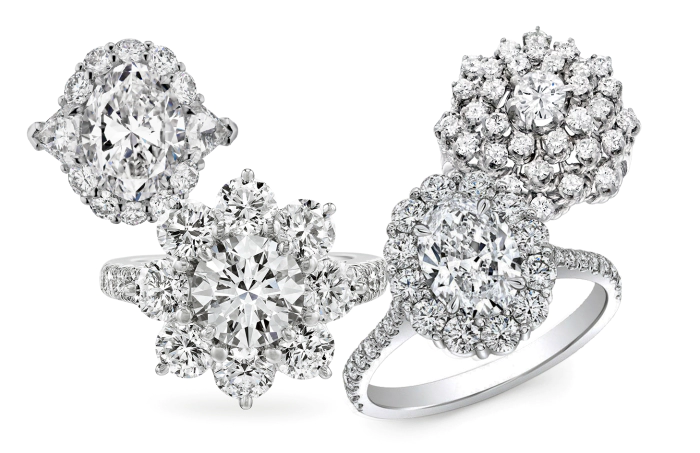- Right or Left?
- Wedding bands
- Diamond engagement
It’s OK to wear a wedding band on any hand you like. Wearing a wedding and engagement ring together is not traditional. Americans wear their wedding bands on the left hand’s fourth finger, but people of different cultures often wear them on the right hand.
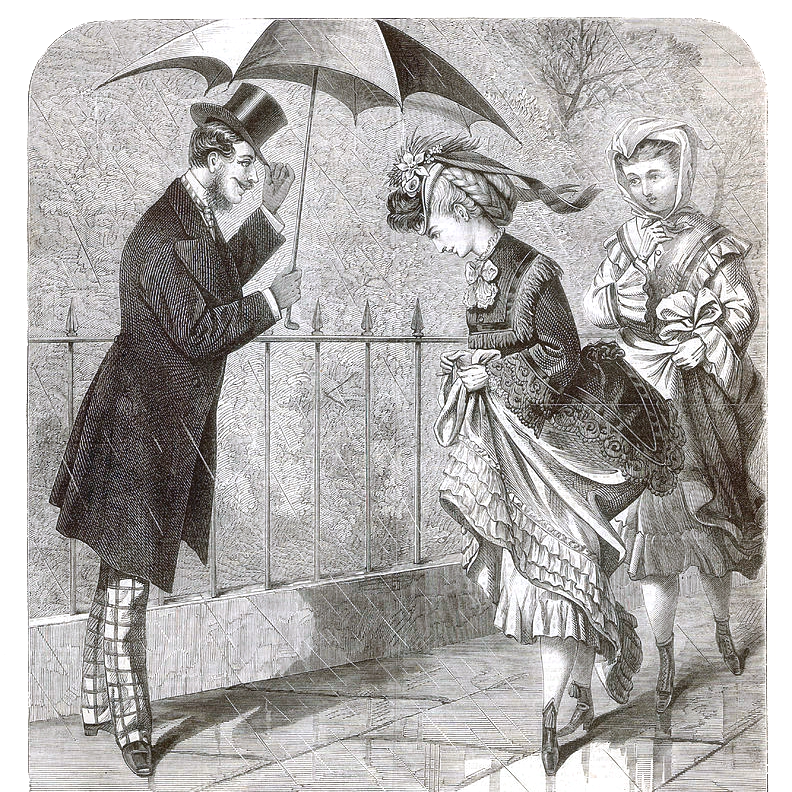
Right or left hand?
According to Western lore, the ring finger is the weakest and cannot be used independently and, therefore, the best finger for a wedding band. The belief has existed since at least the fifteenth century and is based on a mix of ethnic, cultural, and religious traditions.
Supposedly, archeologists discovered a seventh-century burial containing human remains with a gold ring resembling a wedding band on the left hand. This is the base of the modern belief that women should wear the band on the left hand’s fourth finger.
The practical reason for wearing an engagement ring on the left hand is that it keeps the ring out of harm’s way. Most people are right-handed and use their left hand less often. Unlike a thumb or an index finger, the ring finger is the least used and protected on both sides by the little and middle fingers.
Differences between two rings
An engagement ring (a betrothal ring) marks a person who is engaged to be married. Historically, the ring served as a token of financial commitment and a placeholder for virginity. An engagement ring is an essential element of the proposal, a cornerstone of a traditional marriage.
A wedding ring is a gold, platinum, or even silver band exchanged at the wedding ceremony as the official symbol of the union of marriage and worn from then on. A wedding ring doesn’t have a top or bottom, and its width and height are uniform, hence the term “band.” A diamond-encrusted eternity band is a recent invention made possible by a glut of small machine-cut diamonds. A wedding ring signifies eternal love, commitment, and happiness.
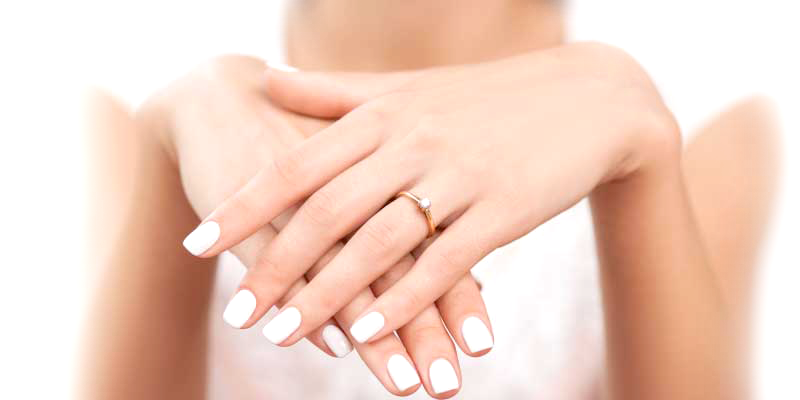
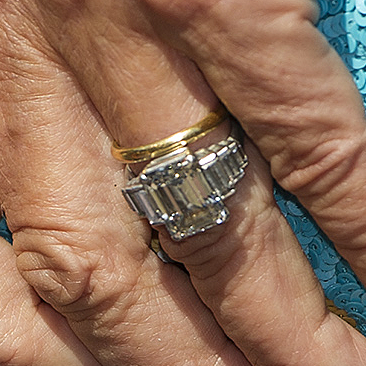
Case for wearing rings apart
Wearing a wedding band next to an engagement ring is a cause for concern and should be avoided. We advise wearing engagement and wedding rings on different hands to preserve their precious uniqueness and beauty. Of course, joining both rings for special occasions is OK, but continuous wear will inevitably wreck at least one.
The friction between two rings will cause damage, the extent and speed of which depends on the fit and how they stack against each other. The damage accelerates when the rings are too big for the finger and there is a lot of movement. A tight fit and carefully selected band style can mitigate and slow the process.
The damage occurs in several ways. A wedding band can chew through the engagement ring undercarriage, eventually carving itself a tunnel. After many years, it will look like it was made on purpose. In return, the engagement ring rips off the beads holding wedding band diamonds, causing them to fall out. Direct contact between diamonds causes the most extensive and usually irreparable damage. Diamonds-against-metal or metal-against-metal friction causes metal to wear off, weaken, and eventually break unless two rings are permanently welded or fused into a single ring with an off-center stone that looks crooked.
Why two rings?
Do we need to combine the engagement and wedding rings once married? A wedding band next to an engagement ring feels more like an unnecessary extension that steals attention away from it. In fact, with age, most people tend to wear a wedding band solo.
Traditional engagement rings typically have one dominant stone symbolizing purity, love, passion, and closeness between partners, standing alone or accented by smaller stones. An engagement ring is usually given as part of the proposal, or if not, at an early point in the engagement. Modern brides demand more say in the choice and design of the rings and are open to wearing one at a time.
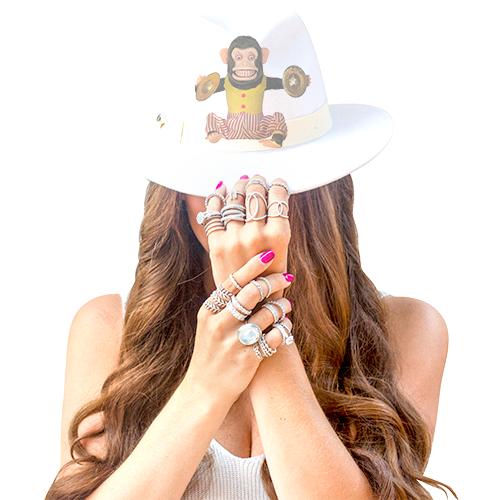

Questionable aesthetics
A wedding band sitting flush with an engagement ring is not recognized as a separate piece, defeating its primary purpose of a marriage symbol. A wedding band designed to fit flush is visually an inseparable part of the engagement ring. It makes the engagement ring look thick and lopsided.
Wearing a band that curves around an engagement ring seems convenient, but it isn’t. Firstly, a curved wedding band looks silly without the engagement ring next to it. Secondly, the addition severely compromises the elegance of a fine engagement ring. The curved border looks awkward and forced, like a car with a mattress tied to its roof.
Even a traditional eternity band can affect the appearance of the center stone. A stone looks smaller next to a large wedding band. We recommend a thin wedding band set low to the finger for most people who refuse to separate the two rings. For pave-set bands, bright-cut pave edges provide additional protection for the stones. Wearing a wedding band and an engagement ring together is not a symbol of everlasting matrimony but a recipe for disaster. Wear each ring on a different hand so they last an eternity.
Beware of the sales pitch
Wearing both rings next to each other is often explained as “tradition.” In reality, it is a clever marketing ploy by jewelers to sell more rings. Retailers stand to benefit from wear and tear inflicted by this custom. They argue that rings have to match, making consumers wary of getting wedding bands from competitors unable to match them exactly.
An exact twin of the engagement ring is a popular but uninspired choice. It is usually too dainty and insignificant to be worn by itself. The excessive wear and tear both rings inflict on each other works to the jewelers’ advantage. The friction causes the rings to wear each other out, leading to costly repairs, insurance claims, and more sales.
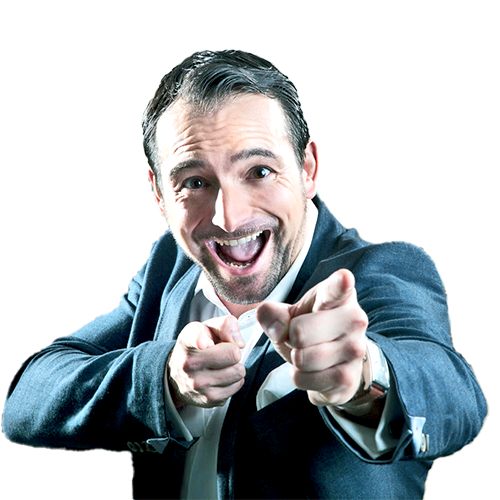
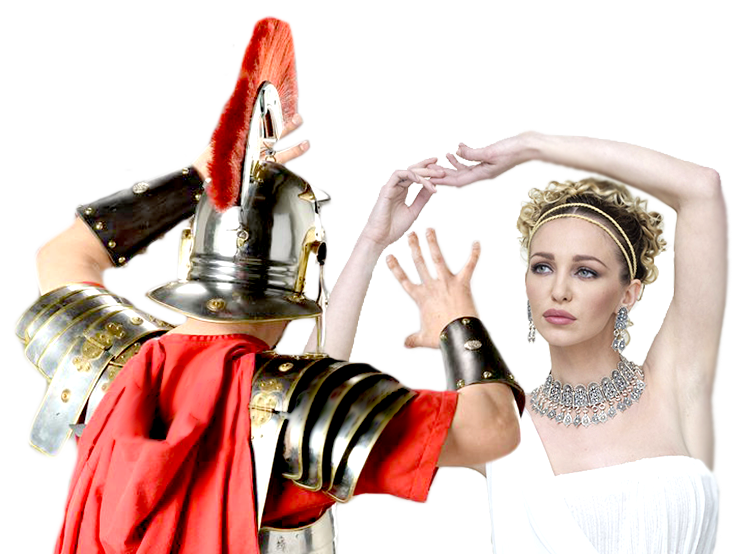
Ring placement history
Historically women wore wedding bands to show subjugation to their husbands. The Ancient Greeks were known to exchange rings as tokens of love and affection. The Romans turned it into a full-blown betrothal tradition. Placing the wedding ring on the fourth finger of the left hand originated with a romantic but mildly idiotic theory that a secret nerve or vein connects the finger directly to the heart.
A Roman grammarian and philosopher, Ambrosius Theodosius Macrobius, got the idea from an unnamed Egyptian priest who insisted that the fourth finger is the most protected. How and where he used his fingers is lost to history. Macrobius went on to promote this “scientific fact” in the social media of the time: the public baths and bathrooms.
Pliny the Elder quotes: “It was the custom to wear rings only on the finger next to the little finger. You saw the statues of Numa and Servius Tullius, didn’t you? Later it became usual to put rings on the finger next to the thumb and even a little finger. Barbarian Gauls and Britons use the middle finger for this purpose. However, in Rome middle finger is the only one excluded. All other fingers are loaded with rings, smaller rings even being separately adapted for the smaller joints of the fingers.”
The prevailing Western custom of wearing the wedding band on the left hand’s fourth finger has existed since the fifteenth century. Isadore of Seville, writing in the early part of the seventh century, declared the fourth finger best suited for a betrothal ring. The Roman Empire likely followed this tradition to its end. The rules governing which side of the body is better suited for engagement and wedding rings have changed many times since Rome fell. Between the 11th and 15th centuries, French ecclesiastical rules placed the nuptial ring on the bride’s right middle finger, except in the rebellious diocese of Liège, which bravely used the fourth finger.
Teenage King Edward VI of England had decreed that the left hand’s third finger should be the ring finger. Luckily, he died from a lung infection at fifteen before making up more ridiculous rules. So until the Reformation, the ring sat on the left hand’s third finger. The 1549 edition of the Book of Common Prayer brought dramatic changes. It required all Protestants to wear the wedding ring on their left hand. These Catholics stuck with the ring on the right hand.
The hippies of the Italian Renaissance hung betrothal rings from necklaces or thin cords and even wore them on hats. The 1493 marriage of Pope Alexander VI’s illegitimate 13-year-old daughter Lucrezia Borgia to Giovanni Sforza was well recorded. The record specified that twin gold rings were set with precious stones and placed on the fourth finger of the left hand, “whose vein leads to the heart.” Apparently, the vein was blocked soon after that because they were divorced in just a few years. Giovanni signed a paper attesting to his impotence, a small price for freedom.
It was not unusual to wear the wedding ring on the thumb during the reign of George I of England (a German who could not speak a word of English), perhaps because enormously big rings were in fashion at the time. A ring was placed on the right hand’s fourth finger during the marriage ceremony. There were exceptions, such as noblemen entering morganatic marriage (marriage between a high noble and a crappy noble or, God forbid, a non-noble) would present his left hand to receive the ring, as in a “left-handed marriage.”
According to Chinese tradition, engagement rings are worn on the middle finger, while wedding rings are worn on opposite hands by the bride and the groom. The bride wears a band on her right hand, while the groom wears his on the left. The Chinese believe that a woman is in charge of the household, so her ring should be on her right hand. The right hand exerts influence according to the custom of “nan zhuo, nu you,” male left, female right.
In ancient Chinese philosophy:
- The thumb represents the parents
- The index finger represents siblings
- The middle finger represents yourself
- The ring finger represents a life partner
- The little finger represents children
With your hands closed and all your fingertips touching, fold your middle fingers since they represent yourself. You can open your thumbs: your parents will not live with you forever. You can open your index fingers: your siblings will leave you to have their own life and family. You can also move your little fingers: your children will settle with their families. But it is impossible to separate the ring fingers because, as husband and wife, you are destined to be together forever.
In the words of Confucius, “It is harder to wiggle out of marriage than wander into it.” 摆脱婚姻比徘徊更难

“Right-handed” countries
A wedding band is generally worn on the left hand in the United States, United Kingdom, Ireland, Canada, Australia, Mexico, Brazil, Iran, Chile, Italy, France, Sweden, Slovenia, and other Commonwealth nations. Germany, Greece, Russia, Spain, India, Colombia, Venezuela, and Poland are the right-hand countries.
Orthodox Christians and Eastern Europeans wear the wedding band on the right hand. In Belgium, the choice of hand depends on the region of the country. In the Netherlands, Catholics wear the wedding ring on the left hand, all others on the right. In Austria, Catholics grace the right hand, but Old Catholics stubbornly use the left hand.
Jewish couples wear the wedding ring on the left hand, even though it is worn on the right hand during the marriage ceremony. Muslims adopted the tradition of wearing wedding rings from the West. While Muslims usually wear the wedding ring on the right hand, there is no set rule or customs. Male Muslims are allowed to wear a ring made from any material except gold. Platinum rings are allowed. In Scandinavia, a jeweler’s dreamland, women wear three rings: one for engagement, the second for wedding vows, and the third for motherhood.
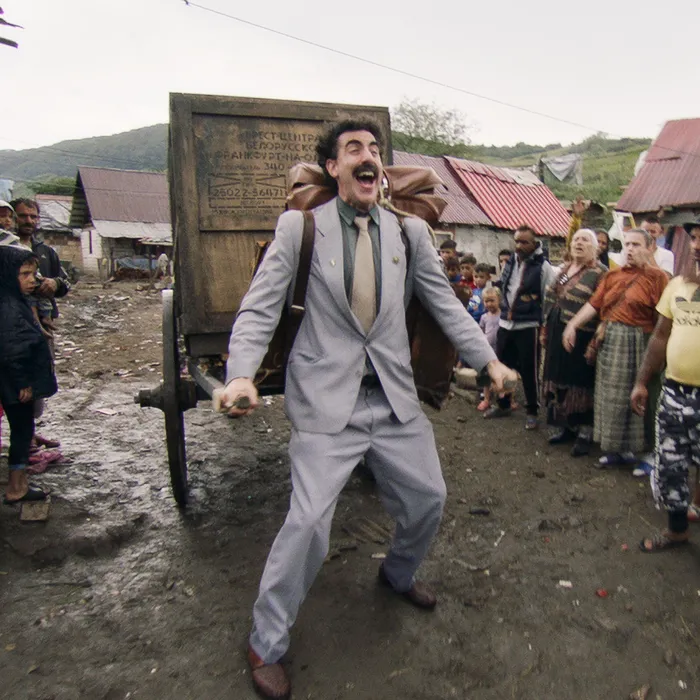

Stacking bands
Stacking two or more bands on the same finger is a popular trend. The bands don’t have to be similar; in fact, mixing different styles looks very attractive. You can also stack bands of different metals or with different gemstones. Stacking bands are usually fair well, as long as they are similar in height. Any scratches from wear can be polished off, except any decorative engraving on the outside walls that might get burned and disappear.
The “Promise” ring
An engagement ring announces to the world the intent to marry. On the contrary, a promise ring has a secret meaning known only to those who exchange it.
Promise rings evolved from medieval “posy rings” inscribed with excerpts from love poems and exchanged between lovers. Promise rings went out of fashion, but some are occasionally gifted by love-stricken adolescents who are not yet ready for a serious commitment. What is promised is not specified but assumed to be sexual exclusivity. The promise ring can be placed on any finger, but most often is worn on the ring finger.
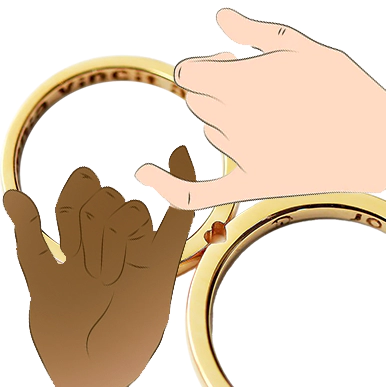

Ring protection
Engagement ring styles have evolved significantly from the past. Contemporary bridal rings are lighter, more delicate, and often set with many small stones called pave. Use extra care during the wear to avoid bumping your precious rings into hard surfaces.
Regularly clean the rings by gently brushing them in soupy lukewarm water.
Visit your jeweler at least once a year to clean, dry, and check for loose stones using professional equipment. By minimizing direct contact between engagement and wedding rings, you can avoid irreversible damage caused by friction.
Minimizing friction
Would the people in the cheaper seats clap your hands? And the rest of you just rattle your jewelry.
John Lennon at 1963 The Royal Variety Performance
There is no ideal solution to the problem, but there are a few possible compromises:
- Welding both rings together. The Frankenring does eliminate friction but makes the ring less elegant. To soften the aesthetic blow, separate two rings with a small gap (about 0.3 mm wide). The rings are connected with tiny, nearly invisible pins but appear independent.
- Curving the wedding band around the engagement ring. Move your melting clocks, Salvador Dali, for here comes “the melting ring.” The so-called “shadow bands” can be hard to find at high-end jewelers, but plenty are sold on the far side of the shopping mall. Look for a small store right between “Jack’s Closeouts” and “Going Out of Business” outlets.
- Using a spacer. A spacer can be a thin metal band between the engagement ring and the wedding band. Also, a spacer can fit the engagement ring precisely in a lock-and-key fashion while its other side is straight.
- Placing the setting on the top of the shank instead of fitting into it. That raises the center stone and eliminates the gallery.
- Adding tongue and groove connections, which are essentially small hooks to lock both rings and prevent them from grinding each other.

A wedding band symbolizes unity, signaling the opposite sex that you are no longer available. A classic wedding band is by far the most popular wedding ring style. It’s a traditional solid metal band featuring a gently curved outer surface and a flat inner surface with chamfered edges. Women tend to wear thin diamond-set wedding bands. Men gravitate toward masculine solid metal bands. We recommend wearing engagement and wedding bands on separate hands to avoid damage.
Advantage of wearing rings apart from each other
Wearing a wedding band next to an engagement ring is a cause for concern and should be avoided. We advise wearing engagement and wedding rings on different hands to preserve their precious uniqueness and beauty. Of course, joining both rings for special occasions is OK, but continuous wear will inevitably wreck at least one.
The friction between two rings will cause damage, the extent and speed of which depends on the fit and how they stack against each other. The damage accelerates when the rings are too big for the finger and there is a lot of movement. A tight fit and carefully selected band style can mitigate and slow the process.
Several factors contribute to the damage. A wedding band can eventually carve a tunnel through an engagement ring’s undercarriage. In time, it will appear to have been made intentionally. Consequently, the wedding band diamonds may fall out as a result of the engagement ring ripping off the beads holding them. Direct contact between diamonds causes the most extensive and usually irreparable damage. The friction will wear off the metal, weaken it, and eventually break it unless two rings are permanently fused together. Although it eliminates friction, it turns the two rings into a single crooked ring with an offset center.
Comfort fit bands
A wedding band’s inner surface can be puffed up for easy sliding on the finger and a cushiony feel. It is a Comfort-Fit for Americans and a Court for the British. In contrast, the standard “pipe-cut” wedding bands are flat inside, lightweight, and cheap. A Comfort Fit band benefits those who take off the band frequently, such as medical professionals. Narrow wedding bands less than 3.0 mm wide do not cause discomfort and do not require Comfort-fit. A Light Comfort-fit is slightly less rounded, while a Heavy Comfort-fit has a bumpier curve. There is no uniform Comfort-fit profile; each manufacturer has a different template. All Leon Mege bespoke wedding bands feature our exclusive Effortless Glide™ edge that allows the rings to slip on effortlessly and stay tight on the finger, thanks to the smooth finish and soft chamfered rims for maximum comfort.
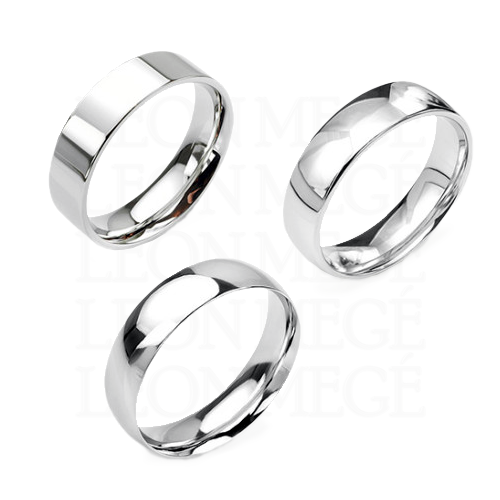

Wedding bands profiles
Classic wedding bands vary in depth, weight, and thickness. There are low, medium, and high dome bands. Alternatively, they might be called medium-weight, heavyweight, or extra-heavyweight bands.
In addition to depth, weight, and thickness, a wedding band varies in shape. The shape of its cross-section defines a band’s style and is called a “profile.” In theory, a wedding band’s profile can be any shape, but the most popular profile is the Dome shape or D-shape. A band’s width is easy to decide simply by trying it on one’s finger. The choice of the profile is a bit trickier.
A High Dome D-shape band’s maximum possible width is approximately 4.0 mm. Medium Domes are possible up to 6.0 mm in width, and a Low Dome can be made in any width.
The British Court profile is oval with a soft chamfered inner surface and truncated sides, which we call Comfort Fit.
Other British Court varieties include A Square (Flat) Court with a flat outer face, Slight Court, Flat-sided Court, Traditional Court, and Edge Court. The only one missing from this list is a Tennis Court.
A Cushion profile is similar to a Medium Edge Slight Court band. An example of that would be Tiffany’s Lucida band.
Flat or Rectangular bands range from 1.0 mm to 2.0 mm in thickness. They can be of any width. Their similarity to machine parts gives flat bands a more masculine look, often completed with a brushed finish.
Round or Halo profiles range from 1.0 mm to 3.0 mm in diameter and are essentially round wire twisted around a finger. Despite their simple look, Round bands are quite elegant.
Oval bands have a Low to Medium dome profile rounded to match the band’s curvature.
Concave bands are very European and have the shape of kidney beans.
Knife Edge bands are typically used as “spacers” and may feature millgrain on top.
Hinged – Articulated – Flexible bands
Are you aware that ring avulsions, also called degloving, are injuries to soft tissue like a ligament, tendon, or muscle when a wedding ring is suddenly pulled off or pressed hard against a finger, causing bone, blood vessel, ligament, or nerve damage? There is also a possibility of sudden death from venous thromboembolism, a blood clot caused by poor blood circulation.
The hinged band’s flexibility offers a solution to this daunting problem. It has hinges that allow its sections to pivot when pressure is applied. The force gets redistributed, so there is less chance of injury. Each band consists of several links, usually between 3 and 8.
Articulated bands are extremely comfortable for anyone who routinely lifts weights, be it dumbbells or groceries, and for those who find traditional rigid rings uncomfortable.
The pins eventually wear off, but they can be easily refurbished.
Wedding band width and height
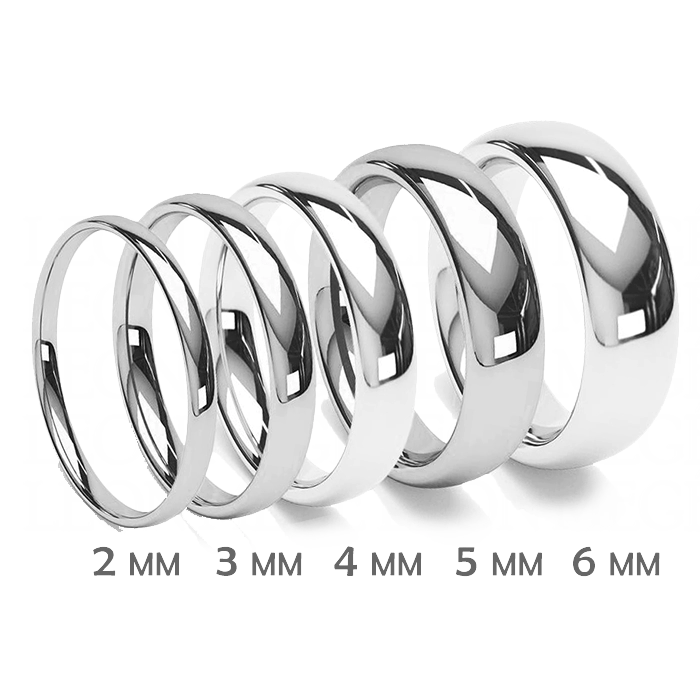
A band’s width is a matter of personal taste and cultural tradition. For example, in the US, men wear wide bands, and women prefer narrow wedding rings, while in some Eastern European countries, the opposite is true. A classic wedding band with its traditional domed profile is the most popular wedding band for men. Men’s bands range from 1.0 to 15.0 mm wide. In the US, men go for 3.0 mm and wider bands, while women prefer a width of 2.0 mm or less.
A band’s width correlates with the finger’s size: a 4.0 mm finger size six band would look too bulky, yet scaled to finger size 16, a 4.0 mm band would look too narrow. 1.0 mm of width compensates for an approximate increase in 3 finger sizes. It means that 5.0mm size 14 and 3.5 mm size nine bands have a similar look on the finger.
Wedding bands are measured by height, sometimes referred to as depth, and by width. The term thickness is confusing because it could mean both width and height. The band’s height starts from the finger and extends to the top. Wedding bands are typically less than 2.5 mm high to prevent discomfort during wear, determined by their width and desired profile. Wider bands have a lower profile to avoid getting uncomfortably high.
- High dome bands ranging from 1.0 mm to 4 mm wide are 1.2 – 1.5 mm thick
- Medium dome bands ranging from 2.0 mm to 6.0 mm wide are 1.6 – 2.0 mm thick
- Low dome bands ranging from 2.0 mm to 10.0 mm wide are 2.1 – 2.5 mm thick.
Wedding bands’ widths range from extremely thin, less than 1.0 mm, to extra-wide, 15.0 mm, or even more. The band’s width affects the comfort as well as the fit. Wide rings feel tight on a finger because they displace more skin.
Wedding band finishes

There are two basic types of finishes – shiny and textured. The shiny surface is achieved by gradually reducing scratches, pits, and other blemishes until the metal is spotless and smooth. A texture can be added during or after the polishing is done. It’s best described as “controlled scarring.” When it comes to different finishes, there is no universal terminology. Don’t be surprised if one jeweler’s satin is another one’s brush.
Properly made bands have a texture only on the outside and never on the inside.
The contrast between polished and textured surfaces dramatically clarifies that texturing is intentional and not resulting from poor craftsmanship.
Here’s an extensive list of finishes available for your wedding band:
High polish is a crisp, bright polish with high-contrast reflections and without foggy spots. 1-2 micron precision is required for the perfect mirror-like finish (Source: “Kruger’s Guide to Industrial Smoothing”). The polish’s brightness depends on metal density and hardness. High luster is impossible on soft, unalloyed metal or a spongy, low-density casting. High polish is best at revealing the luxurious shine of hand-forged metal.
Bright polish is the most popular choice among most women and men. 99.5% of women and 92% of men choose a bright polish for their wedding bands.
Zaratsu or Black polishing can be done on flat surfaces of hard metals (for example, stainless steel) that are polished to a distortion-free, brilliant mirrored finish. It is done by firmly pressing the metal part against a spinning tin wheel primed with finer and finer abrasives. Typically used in the watch industry.
Matte is technically not a texture but a dull polish. Matte is the early stage of polishing a piece to a high-luster finish.
The Satin finish is very fine and smooth. It resembles a surface of silk. The satin finish comprises hundreds of microscopic lines that are invisible without magnification. The satin finish is often achieved by scorching a polished surface with steel wool glued to a handle.
The Iced finish resembles a surface of an ice-skating rink after a hockey match.
The Brushed finish is achieved by manually applying one-directional strokes or using a rotary wheel with abrasive sandpaper. The finish is made of uniform scratches, and their coarseness depends on the grade of sandpaper used.
Stone or Bark finish is a rough, dented surface with a random granular feel. Typically it’s done by leaving the cast surface raw. This finish is popular with pretentious amateur jewelers unable to machine the casting to a clean, crisp finish.
Sabi finish, a Japanese word for “beautiful,” is a coarse finish accomplished by making deep parallel scars with a knife-edge burr. The Sabi finish was named and popularized by the legendary jewelry designer Henry Dunay.
The Florentine finish is a pattern of etched lines crossing each other at a 90-degree angle. The technique makes the metal surface resemble fine fabric or course textiles, depending on how coarse the lines are. A special graver that cuts multiple parallel lines in one stroke can produce the finish. The Florentine finish features prominently in Buccellati jewelry, among many others. Florentine finish’s popularity began fading away in the 1980s.
The Hammered finish has an appearance of a rough, crudely forged surface. The dents are machined with a cutting tool rather than by hammering.
The Acid finish is achieved by applying harsh chemicals that leave thousands of microscopic pits on the surface. It’s a quick way of finishing jewelry on an industrial scale. Frost finish is an alternative name for the acid finish, albeit more poetic.
Sand or Sandblasted finish is a result of blasting the surface with a stream of an abrasive powder. The finished surface resembles a coarser version of the acid finish. Blasting is done under high pressure in a sealed enclosure to prevent inhaling since breathing pulverized sand can lead to a severe medical condition known as silicosis.
The Corrugated finish is a rough ridged surface with irregular trenches gouged at a 45-degree angle. This bizarre texture is found on low-end jewelry and never in fine jewelry.
Granulation is a recently revived ancient technique of assembling decorative patterns from tiny gold beads soldered to the surface.
The Honeycomb finish is a hexagonal relief etched on the surface.
The Knurling is a diamond-shaped (criss-cross) pattern imprinted on a surface to ensure a better grip. Occasionally it is confused with millgraining.
The Distressed finish is an artificially induced aged appearance achieved by rubbing or scorching the band. This is a natural finish that any plain wedding band eventually achieves during normal wear.
The Perlage consists of small, overlapping concentric circles produced by a rotating metal brush.
The Glashütte ribbing is produced by mechanical means. It emulates a gently rippled effect.
The Sunray finish is a spiral pattern typically covering large surfaces in watches.
Hand engraving is a form of artistic etching. Engraving can be replicated during casting, as is done in low-end jewelry. A pattern can be milled using a CNC machine or a laser, but the results are always mediocre. Only when done by a master artist does the ancient art of hang-engraving look terrific. Custom engraving is expensive as it takes a long time, but it’s worth every penny.
Micro-pavé is a surface embedded with small diamonds or gemstones, each serving as a tiny tile. The combination of stones and metalwork is a composite material with a characteristic texture.
Milgrain edge
A milgrain wedding band has an old-fashioned, conservative Ivy League Country Club look that instantly sets you apart. Imprinting a row of tiny beads or semi-spheres on top of sharp edges blunts the edge, conceals uneven spots, and enhances the design by giving it a lacy appearance. Contrary to the writings of some dimwit jewelry bloggers, the word milgrain does not translate to “a thousand grains” in French. The French call it grisant, meaning shaded, greyed out, or dull edge.
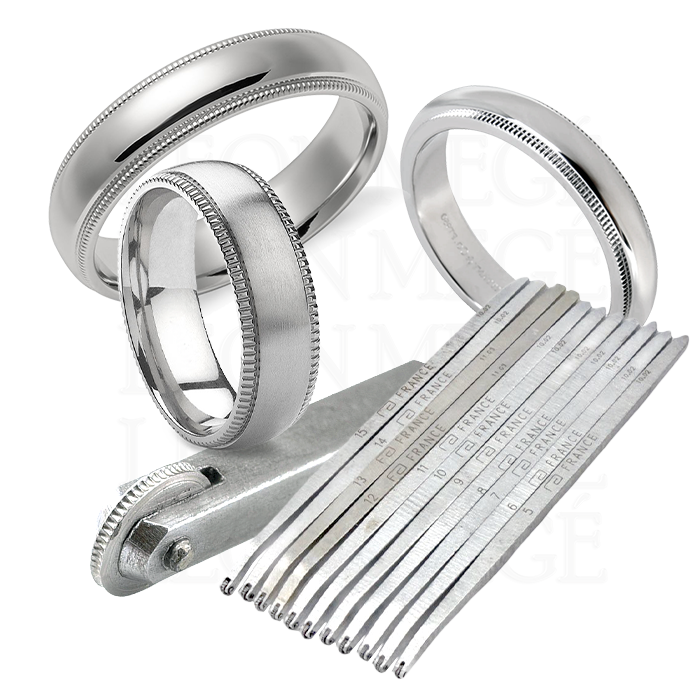
Milgrain is done by rolling a special tool along the sharp edge. In tight spots, milgrain is fashioned one bead at a time using a graver. Imitation milgrain is cast from a mold or a CAD model. It’s vastly inferior to hand-applied milgrain.
Milgrain comes in different sizes ranging from #1 to #15 (0.1 mm wide to 1.5 mm wide). The large milgrain on a dull wide edge resembles reeding on the coin’s edge. The finer and prettier the milgrain, the faster it wears off and disappears, leaving a dull, flattened border in its place. The milgrain can be applied mechanically using a hand-cranked Millrite lathe/vise contraption.
Milgrain is short for “milled beads” or “imprint of grains.” There are alternative spellings of the word: “millegrain,” sometimes “millegraine,” but most often, the term is “millgrain” or “milgrain.”
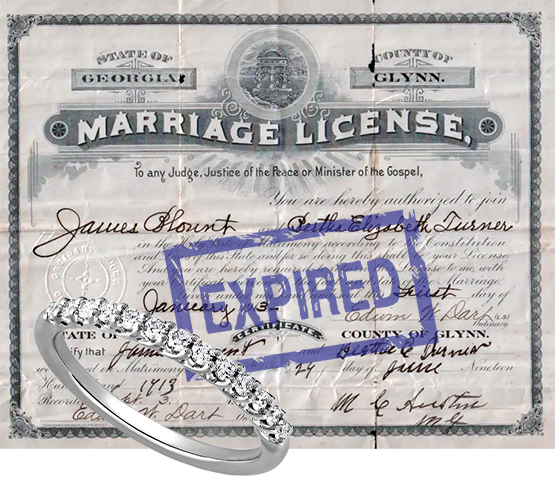
Partially set “eternity” bands
A wedding band encircled with diamonds has a deep meaning. A wedding band symbolizes a marriage lasting for eternity. A marriage license never expires, and so does the endless row of diamonds. In addition, a partially-set band is tacky. It is the jewelry equivalent of Howard Wolowitz’s backless dickey shirt. Contrary to mistaken belief, a halfway-set band turned upside down will not protect from criminals looking to rob someone.
Best metal for wedding bands
Platinum is perfect for bridal jewelry whose purity resonates with the sanctity of marriage. Choosing the right metal is personal, and each material has advantages and disadvantages, but platinum always comes out on top thanks to its rarity and resilience. Platinum has always been a preferred metal for bridal jewelry because of its naturally soft white color and beautiful luster. Its neutral color that doesn’t tarnish or oxidize makes color coordination a snap. Platinum is almost twice as heavy as gold. It feels substantial and constantly reminds you of your marital obligations with its presence. Aged platinum develops a dignified, noble patina, a unique appearance, impossible to reproduce mechanically, best described as distressed “shabby chic,” reminiscent of shimmering rustic silverware punctuated by microscopic dings.
Gold costs almost three times as much as platinum. Why are platinum bands more expensive?
Despite surging gold prices, platinum jewelry is still worth more for a number of reasons:
- Platinum is much denser; the same band weighs almost double when it’s platinum.
- The platinum alloy contains 95% pure platinum, while 14k gold has only 58.3% of pure gold.
- Platinum is usually combined with ruthenium, a platinum group metal, while gold is alloyed with inexpensive copper and zinc.
- Platinum wedding bands are more difficult to manufacture as they require special skills and expensive machinery.
Silver – defense against vampires or a New Age fad?
Once more valuable than gold, silver has been prized for centuries. However, its relative softness has hampered traditional use for making wedding bands, and silver tarnishes very quickly. Pure silver is too soft to be used in jewelry; it must be alloyed with copper to boost its strength. Sterling silver contains at least 92.5% of pure silver.
Gold wedding bands
Gold wedding bands have been on the decline since the 70s. Historically, its rich yellow color was a significant draw, but today, gold is increasingly a symbol of excess and insensitive extravagance. Women and men have been shunning it for many decades now, and it appears that gold is not making a comeback in bridal jewelry. For example, in an episode of the popular Sex and the City, the yuppy icon, Carrie Bradshaw, is dry-heaving at the news that her boyfriend is getting her a gold ring.
Rose gold
Pink gold is an upscale alloy associated with wealth, glamour, and grandeur, but it lacks the glitz and extravagance of its yellow cousin. Pink, red, or rose gold (the same thing; “rose” sounds more romantic) is highly durable and resistant to scratches and dents. It owes its beautiful, tender color to a higher share of copper in its alloy. Copper is also responsible for rose gold’s exceptional hardness, which makes high-luster polish possible.
Rose gold owes its prominence to Russians, who used it in all types of jewelry, from Carl Fabergé’s famous Easter eggs to tea kettles for wealthy merchants. In Russia, up until very recently, pink gold was considered the natural gold color, earning it the nickname “Russian gold.” There are a few drawbacks—even 18k rose gold tarnishes fairly quickly. It is also more difficult to hand-forge.
Is a white gold band a good option?
White gold is a poor choice for a wedding band. Created as a platinum substitute (a scarce strategic asset during the war), white gold remains a poor stand-in for the real white metal of the jewelry world. White gold is usually plated with rhodium to conceal its yellow tint. A thin layer of rhodium (a white metal in the platinum group) is applied to the surface, giving white gold its bright white shine. Rhodium is very hard, so it provides a degree of protection from scratches until its thin layer wears or peels off. That’s why white gold jewelry must be “dipped” repeatedly to reapply rhodium.
Some jewelers falsely claim that their white gold alloy is so white that it does not require rhodium plating. It’s not true; all white gold alloys have approximately the same hardness. Consumers are also often misled into thinking white gold is harder than platinum. This is false; platinum is harder.
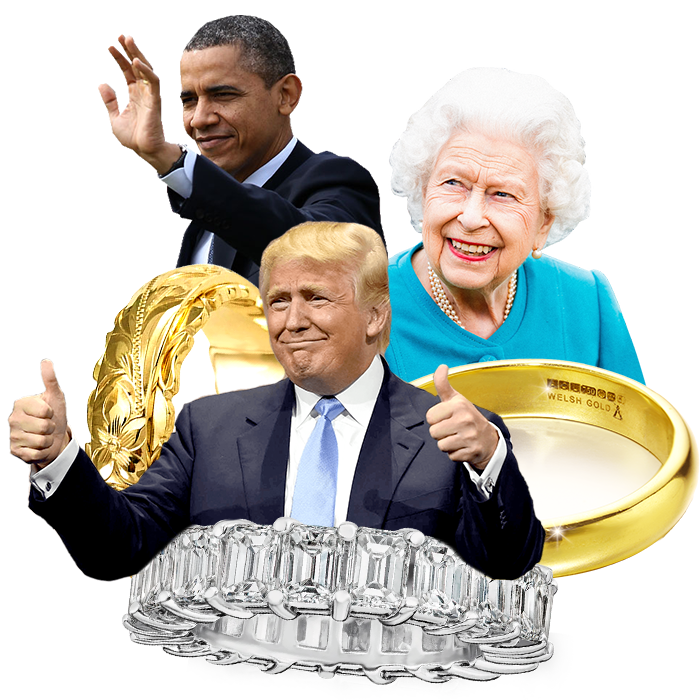
What do Presidents and Royalty wear?
Traditionally, the British Royal wedding bands, including the one Queen Elizabeth II, wears, are fashioned from rare Welsh gold. It sits behind her engagement ring set with diamonds ripped from her late husband’s mother’s tiara. Prince Charles wears a gold signet ring layered with his Welsh gold wedding band on his left hand’s little finger in a medieval fashion. Is it a sign of his individuality, as he claims, or a clever life hack to halt the finger from sliding onto his enormous schnozzle?
 Duchess Camilla’s gold wedding band paired with her gangsta-size diamond doesn’t distract from her Rottweiler features. Princess Diana wore a Welsh gold wedding band until the Firm arranged for her fatal ride. In a bold move, follically deprived Prince William decided not to wear a gold wedding ring when he married Kate Middleton.
Duchess Camilla’s gold wedding band paired with her gangsta-size diamond doesn’t distract from her Rottweiler features. Princess Diana wore a Welsh gold wedding band until the Firm arranged for her fatal ride. In a bold move, follically deprived Prince William decided not to wear a gold wedding ring when he married Kate Middleton.
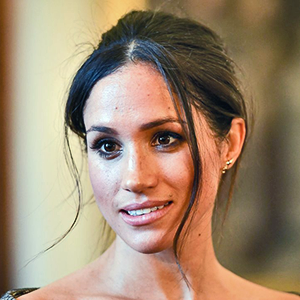
Meghan Markle’s wedding band is made from the same Welsh gold stash used for royal rings. Prince Harry’s platinum wedding band has a textured finish that pairs well with Nazi costumes. Princess Eugenie caused a stir when her Welsh gold wedding band was too tight for her souped-up fingers during the wedding ceremony. After three years of dating, Nancy Reagan was married to Ronald for 52 years. She didn’t wear an engagement ring, but she wore a platinum diamond wedding band.
Hillary Clinton reportedly turned down an engagement ring in favor of pork futures. She and Bill exchanged family heirloom wedding bands.

Mr. Obama’s wedding band was a thick, carved gold band from Indonesia, where he lived from age 6 to 10. The conspiracy theory that Mr. Obama’s wedding ring was inscribed with the first half of the Islamic declaration of faith, the Shahada: “There is no god except Allah,” is a hoax.
Melania Trump wears a 13-carat platinum eternity band with fifteen emerald-cut diamonds. The rumors of a Q diamond color are baseless. Supposedly, Donald bartered the $200k Graff eternity band worth $1.5 million for TV promotions on The Apprentice.
Celebrity wedding bands
A quick look at celebrities gives us a great insight into the broad scope of wedding band styles. They rip through scores of marriages faster than fire through a box of matches. Each marriage has a wedding band that is different from the one before. Celebrities have a pompous habit of attributing deep spiritual meaning to their jewelry to justify their extravagant vanity. The PR helps with landing cushy movie roles without visiting Weinstein’s stained couch.

During a secret civil ceremony, Joe DiMaggio presented Marilyn Monroe with a platinum channel-set band with 36 baguettes. It wasn’t her only wedding ring, but it was sold for $772,500 at Christie’s in 1999, even though one baguette went missing. An astonishing price for the mediocre band worth less than $20,000 even today. It took about a baguette per week to keep the two American icons in an enduring romantic relationship that lasted only nine months.
Before Jennifer Lopez’s marriage ended in divorce, she often ditched her gold wedding band because it just didn’t go with her platinum rings. Most fashionistas agree that mixing gold and platinum jewelry is a big no-no.
Before her divorce from Kanye West, Kim Kardashian wore an ultra-thin platinum micro pave band – a surprisingly understated piece for her luscious form.
Carrie Underwood wears a curved diamond wedding band to accommodate her engagement ring. The platinum shadow band is said to be as unique as her singing style.
Scarlett Johansson wears a thick gold wedding band as per the Russian heritage requirements. Russian women favor bands as wide as a truck tire.
Chris Pratt wears a plain gold wedding band. In the movie “Passengers,” his character crafts a wedding band using platinum stripped from the spaceship’s fusion reactor. At least, that’s what they want us to believe. We think he steals the ring from a jewelry boutique onboard.
Adam Levine got a plain platinum band for himself and a finger tattoo for his Namibian-born shiksa. “The tattoo is still there when I take my engagement ring off,” she said. “Wow, that was cheap,” he thought.
Amal Clooney’s dainty micro pave band sits flush against the platinum engagement ring she got from George. It’s not a million in a Tumi bag that each of his pals got from him, but still a nice gesture.

Alternative materials
Gold, silver, and platinum aren’t your only metal options when buying a wedding band. From traditional to ultra-modern, there are plenty of materials to consider.
Medical personnel can remove zirconium, titanium, and steel rings from the finger using special ring cutters. Still, it’s a major headache, so medics will not appreciate your taste in alternative metals.
Palladium is a naturally white metal that is visually indistinguishable from platinum. It is one of the rarest metals on Earth. A decade ago, palladium was considered a cheap platinum substitute, costing a fraction of platinum’s price. Today, palladium is twice as expensive as platinum. Even Bitcoin millionaires will think twice before ordering a band made out of palladium. Palladium is lighter than platinum, very durable, and hypoallergenic.
Titanium is among the strongest and most lightweight metals for wedding bands. Those exhausted from wearing heavy platinum bands can finally be relieved by titanium’s almost plastic-like heft.
Stainless steel rings are strong and cheap. They can be polished to a shiny chrome finish or brushed for a pewter look. Either way, you’ve got yourself a shiny piece of hardware.
Damascus steel rings are made of two alternating types of stainless steel layered together to create striped patterns. Some layers are chemically darkened to add a dramatic contrast similar to zebra skin.
Meteorite iron is often incorporated in wedding bands combined with other metals, such as titanium, platinum, and gold. Stellar-born superheated meteorites fallen on Earth slowly cooled over billions of years, causing iron molecules to settle into a crystalline Widmanstätten pattern that does not occur elsewhere on Earth. Tungsten, or Wolfram for Krauts, is a silvery metal identified as a new element in 1781. It is four times harder than titanium and hypoallergenic but, unfortunately, prone to shattering. Because of their hardness, tungsten rings have a brilliant, vitreous shine.
Tungsten rings cannot be sized, but this is rarely an issue. Tungsten rings are very inexpensive and can be easily replaced.
Cobalt is a bright white metal known as “poor wife’s platinum.” It is heavier than other non-precious metals, which gives it a substantial feel. It’s perfect for those who want to always keep in touch with their wedding vows.
Ceramic wedding bands may look cool at first, but they are more appropriate for teenagers. They are so cheap that you may want to marry a few more times to enjoy the bargain.
Wood can be found in wedding bands as an inlay in titanium, ceramic, or tungsten. Whole rings may also be carved out of a solid piece of wood. These rings are not indestructible and require extra care to stay presentable. On the plus side, they’re dirt cheap.
Dinosaur bone rings contain fossilized bones of Barney and his friends. His remains are cut up and used for inlays combined with meteorite iron, exotic wood, or other equally fascinating materials. A grim reminder that our remains might end up in family court one day.
Zirconium is a grayish-white metal that is similar to titanium but has a ceramic-like feel to it. Zirconium is shatter-proof, relatively lightweight, skin-friendly, and cheap. Zirconium darkens when exposed to oxidation, so zirconium bands are usually jet-black. Zirconium is used in nuclear reactors due to its high heat and corrosion resistance, so it’s a safe bet that Homer Simpson wears a zirconium band.
Antlers of many different species, colors, and textures are used as an inlay material in wedding bands, serving as a constant reminder of senseless animal murder. Some animals died before their remains were dug out and desecrated.
Carbon fiber is a very lightweight, durable material made from organic polymers. These wedding bands are made entirely from carbon fiber or used as inlays. Carbon fiber rings are pretty durable and cheap.
Mokume gane technique
Mokume-gane is a highly specialized technique perfected by the Japanese of imitating wood-like texture on a metal surface (hence the name: mokume – wood grain and gane – metal 木目金 ). Various metals and alloys are fused to produce a laminate with a uniquely patterned finish. This stock is used for making wedding bands.
Denbei Shoami, a Japanese metalsmith, is credited with inventing the technique for decorating samurai swords. Like wood graining caused by naturally alternating harder and softer layers of wood, the patterns in mokume gane are due to each metal’s different physical properties – hardness, toughness, resistance to corrosion, etc. As pretty as they are when new mokume gane bands quickly deteriorate and lose their look. They generally cannot be sized and cost too much for a novelty item.
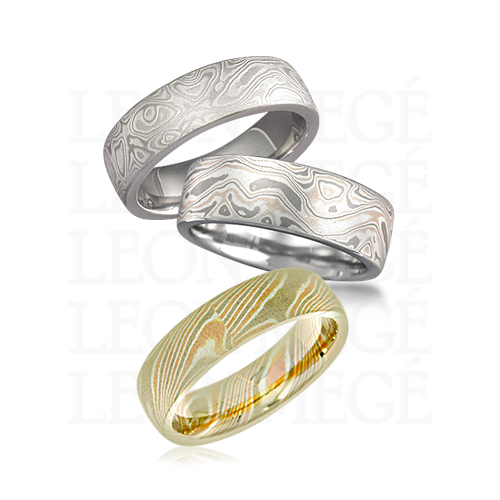
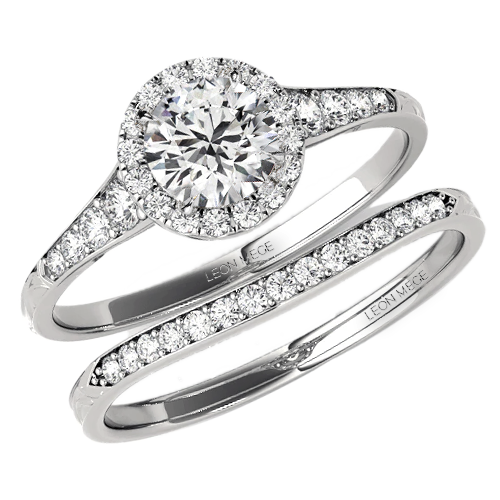
Shadow wedding band
A shadow wedding band has a curved section that fits flush next to an engagement ring. Useless on its own, the band has many different names such as “curved band,” “fitted band,” “molded band,” “custom shaped band,” or “waveband.” The aesthetically challenged wavy band looks awkward and makes no sense as a symbol of marriage.
Cartier “Rolling band”
The “Rolling” band is a name coined by Cartier for interlinked multicolored bands symbolizing all aspects of a relationship: white is for friendship, pink is for love, and yellow is for fidelity. Each band, a set of several, usually three, is connected to the other two, allowing them to slide on the finger easily by rolling over each other. The Cartier Trinity band is one such example. A rolling band finger size cannot be measured on a ring stick – it must be tried on.
According to legend Jean Cocteau saw Saturn’s rings in a dream, and his friend Louis Cartier turned the dream into a reality circa 1924. The ring design existed long before Jean and Louis went interstellar; such bands were commonplace all over Eastern Europe. However, Cartier beat Russians and Poles to the punch expropriating the design to call its own.
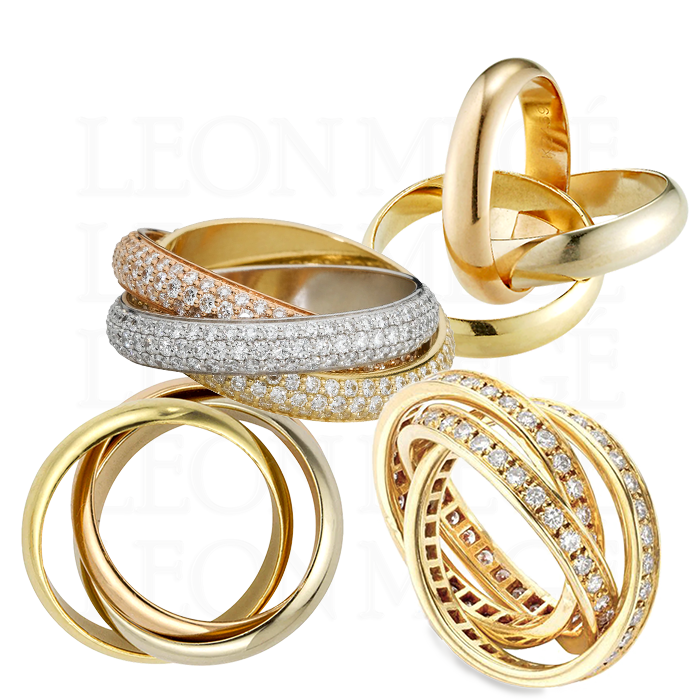
What makes Leon Megé’s wedding bands unique?

The mathematically derived templates developed by Leon Megé over decades of research maximize elegance and comfort in the final product. Leon Megé bands are distinguished by refined lines: precise, elegant curvatures that determine the look of any classic wedding band.
Leon Megé forges traditional, upscale wedding bands from high-grade platinum, sealing rough spots with a high-frequency laser beam. There are no soldering joints or casting seams.
Leon Megé’s bench-made classic wedding bands are available only to customers who have purchased an engagement ring from us.
A puzzle ring is made of disfigured links assembled tightly together so it appears solid. Once the rings have been dislodged from their places, it’s up to the wearer to solve the puzzle. The rings can be reassembled by turning each piece in a certain way following a predetermined sequence of steps. Directions for solving rings’ puzzles are usually supplied. Patience is required because forcing, compressing, or bending the parts will destroy the ring.
Puzzle rings are rarely used as wedding bands, but when they are, they can prevent cheating. The mechanism of how they work is unknown, but based on historical records, Middle Eastern rulers used to require each of their wives to wear a puzzle ring to guarantee her fidelity.
Puzzle rings were invented at least 2000 years ago and appeared in Europe during the Renaissance. They remain popular in the Middle East. When you travel to Damascus, pick up a puzzle ring at the Souk El-Hamidiyeh shopping center. While you are there, pick up a scoop of ice cream at the venerable Bakdash ice cream parlor.
A ring jacket, also called a ring wrap, a ring enhancer, or a ring guard, is an old-fashioned concept that’s gone out of style but is still being used today.
A jacket is made of two connected shadow bands with a space in the middle where an engagement ring can be dropped. A ring jacket is usually a way to add a “dressier” option to an engagement ring. It also adds stability to the ring and reduces spin. A ring jacket makes it possible to update the look of a unique engagement ring without changing the ring itself.
Using a ring jacket as a wedding band is a no-no. You cannot wear it without the engagement ring, and it looks like a part of the engagement ring when worn together.
Women overwhelmingly prefer wedding bands set with diamonds over plain metal bands. Even the Orthodox Jews required to wear a solid band at the wedding ceremony often set it with diamonds once the nuptial formalities are out of the way.
The choice of a wedding band depends on how the wedding band is worn. The majority of women wear engagement and wedding rings on the same finger. This eventually causes damage from friction to both rings, so we don’t recommend it.
For those who wear both engagement and wedding rings together, a pave-set band makes the most sense. A pave band works with any engagement ring regardless of the diamond’s shape.
There are two basic styles: soft blurry outline of modern pave, and bright-cut pave with well-defined rigid edges. Engagement rings with emeralds or Asschers are complemented by bands with a bright-cut pave. A modern-style pave works well for rounded stones such as ovals, cushions, pears, marquises, and, of course, rounds.
A thin low-sitting wedding band is key to minimizing friction. The choice of a bright-cut style pave offers better protection than a modern pave. A thin, dainty pave band will stay closer to the engagement ring without a large gap in between. It’s recommended to keep the band’s width to the minimum since a wedding band should not compete but rather complement the engagement ring.
For those who wear engagement and wedding rings separately, the possibilities are endless. A woman can wear a more substantial wedding band with larger stones without potentially overpowering her engagement ring. Any diamond shape or a combination of shapes is fair game. Larger stones can share prongs, hence the name “shared-prong” bands. Eternity bands can also be bezel or channel set.
To tie both rings stylistically, pair a step-cut diamond with a step-cut-set wedding band, while a brilliant-cut band can accompany a brilliant-cut engagement ring.
Any band can be used in a stack, including most wedding bands. The key in assembling a stack is using bands that are approximately the same height so that none stick out.
A stack allows you to mix bands in many arrangements according to your mood, occasion, or dress. A stack of bands is popular, fashionable, and even trendy. Adding a wedding band to the mix is a fun way to add more flexibility without buying more rings.
Unless an heirloom band stays in the family for generations and has sentimental value, there is no reason to re-use someone else’s ring.
There are two reasons for a used wedding band to be sold: whomever it was made for, it didn’t work, or its owner passed away, and the surviving party did not feel overly attached. Do you want this twisted karma to affect your eternal happiness? We all know that curses and jinxes are silly superstitions, but would you like to spend your married life proving that?
Unlike an engagement ring, a wedding band is usually not that expensive. If you cannot afford gold or platinum, get a silver one. Still too expensive? Steel, wood, or ceramic bands are super cheap.
A wedding band is worn nonstop, so ensuring it’s entirely safe for your skin is a priority. “Hypoallergenic” metals are those that are least likely to cause an allergic reaction. All metals except platinum can cause an allergic reaction.
Moisture from frequent hand washing or swimming can be a possible cause of skin irritation. Perspiration, lotions, and household chemicals trapped under the wedding band can also cause irritation. Cleaning your wedding band regularly and drying it thoroughly after washing your hands can rule out allergies. If you continue to have irritation caused by your wedding band, consider getting a divorce.
Nickel, zinc, copper, and lead used in metal alloys can cause allergies. Nickel allergies are prevalent and quite severe. European Union bans the metal from use in gold alloys. Unfortunately, the majority of white gold jewelry sold in the US is made with nickel alloy. It is worth noting that Leon Mege jewelry is never made using nickel alloy. If you are aware of any metal allergy that you might have, you can contact us to make sure the ring you’re interested in is safe for you.
Since the human body does not react to platinum and palladium, these metals are used for biomedical applications. Both are completely safe for people with sensitive skin. Platinum is 75% denser than palladium and 20 times as dense as water. Palladium is a precious silver-colored metal very similar to platinum in appearance. It’s almost as light as gold but more pliable. Both metals can be formed into virtually any shape and suited for all jewelry applications.
Yellow gold is generally hypoallergenic if it contains a minimum of 75% of pure gold – 18k or higher. Copper and silver used for alloying gold rarely cause adverse reactions, but zinc occasionally does. Gold alloys are significantly less hypoallergenic than platinum or palladium. White gold should be avoided because there is a strong chance it contains poisonous nickel.
Cobalt is a scratch-resistant, cheap, dark silvery metal used to make wedding bands. It is used in dental and orthopedic implants for its hypoallergenic properties and durability. You can also consider surgical stainless steel, whether it fell from the sky in meteorites or was melted by humans. Stainless steel wedding bands are cheap and safe to wear. When everything else fails, consider zirconium – a lightweight and hypoallergenic material. You can’t go cheaper than that.
Retailers love matching wedding band sets, and what’s not to love – two sales with one sales pitch. A matching set usually consists of two same metal but different styles bands or similar style bands in a different metal. When the couple is together, matching bands are so sugary sweet you can get diabetes just by looking; when they are away from each other, nobody will know anyway.
His’n’her’s wedding band sets are popular in Europe, where couples are not embarrassed to wear identical rings. Such conformity of tastes between a man and a woman is unhealthy. Women deserve something more special, beautiful, and feminine. Men require something more masculine and straightforward.
There are exceptions, of course, but we advise dismissing the idea of a matching wedding band set. Show your individuality! Otherwise, we would end up marching in goosestep, wearing identical Hugo Boss uniforms and saluting each other with the right arm extended at a 30-degree angle.
The hardness of platinum and white gold alloys is based on the Vickers scale (HV). The higher number indicates a more rigid metal. There is a significant difference in hardness between hand-forged (cold-forged) metal and metal produced by casting.
How metals stack up from the softest to the hardest:
110 HV – 5% iridium platinum cast – incredibly soft, not suitable for hand-forging
130 HV – 5.0% ruthenium platinum cast
135 HV – 4.5% cobalt platinum cast, the relatively soft magnetic alloy used in mass production
150 HV – 18k yellow gold cast
190 HV – 18k palladium white gold cost
210 HV – 18k hand-forged yellow gold is used for bench work. High-end jewelers use 18k gold exclusively.
216 HV – 18k palladium hand-forged white gold. This alloy is rarely used because of palladium’s high cost. Platinum is the better option.
220-230 HV – 5.0% ruthenium hand-forged platinum. Used in high-end jewelry. All Leon Megé jewelry is made using this alloy.
220 HV – 18k nickel white gold. This alloy has a significant yellow tint. It may cause severe allergic reactions and is illegal for use in jewelry in the European Union.
350 HV – 14k nickel white gold – rock-hard, dangerous, pale yellow, allergy-causing alloy, illegal in the European Union.
There are many different types of wedding bands unique and memorable, and there is hardly any need to personalize them.
For those whose ego yearns for more, hand engraving or setting a secret birthstone is a solution. Both are popular and affordable options for adding a personal touch to a wedding band. An engraved wedding date can also help to avoid the embarrassment of forgetting an anniversary. There are also various novelties, such as a digitally enhanced fingerprint molded on the band.
Very thin, flat bands can be used to separate a wedding band from an engagement ring to avoid damage from friction. This is a viable option if both rings have pavés, especially on the sides where they would be touching.
A spacer can also be added to a stack as an accent to vary the mix.
Engraving is the art of decorating metal by incising a pattern of grooves onto its surface. An engraving can be an inscription or a pattern. Cheap machine engraving, the type used for personalizing trophies or dog tags, is done with a marking machine or a laser.
Genuine engraving is done by hand using a special tool made of tempered steel. It’s called a “graver” (“burin” or “échoppe” in French, “stichel” in German). A professional engraver is an artist who uses metal as a medium. Precise work on a microscopic scale is challenging. Very few people are capable of such meticulous craftsmanship.
A hand inscription is an excellent way to make a wedding band special. An inscription is usually hidden inside the ring. On occasion, it can be on the outside for the whole world to see.
Engraving is done when the band is finished and polished. Therefore, it’s a good idea to try the band to ensure the perfect fit. Adjusting the size can damage the engraving, so it might need to be done again. Decorative engraving is done to hide and beautify exposed metal surfaces. It is often done on the top and the sides of a band.
An engraving slowly wears off over time and can also be damaged during ring sizing. Although an engraving can be restored, an inscription tempered by time radiates a more profound meaning and should be left alone.
Wedding bands often carry a personal inscription immortalizing the couple’s feelings towards each other. Usually, it is a line from a poem, a verse from a favorite Holy book, a Chinese letter from a takeout menu, or anything else deeply meaningful to both parties.
The limited space inside the band, already taken up by stamps and hallmarks, calls for a short, abbreviated version of an endearment. A couple of short words will do.
Engraving the wedding date is popular and even helpful. It can prevent those embarrassing moments in a couple’s life when a spouse forgets an anniversary.
The inscription is meticulously carved by a professional using a special tool. It is tedious and expensive, but the result is entirely different from cheap machine engravings you get at the mall.
“…In chemistry, the diamond, being pure carbon, is one of the most common elements. Yet it fashioned by nature into a magnificent crystal with the most dramatic history of all gems…” ~ C.W. de Kiewiet
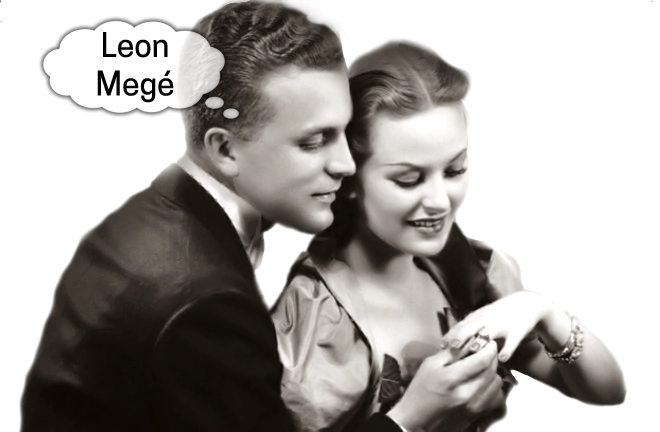
Engagement ring’s meaning
An engagement ring is a universal symbol of love and commitment. It has an additional meaning as a status symbol.
Early engagement marks were as simple as grass braids tied around the wrist or ankle. It was a nice addition to a dowry, usually consisting of a few sheep or cows. In the old days, men in power used rings as tags to track their wives and concubines. Puzzle rings and ornate bands were popular in the East, while the European tradition favored rings set with inexpensive gemstones.
By the end of the Middle Ages, diamonds appeared in betrothal rings, and by the 20th century, diamonds were set in almost every engagement ring. Even today, finding a couple without an engagement ring is hard. Even when called by other names, such as a “promise ring” or a “friendship ring,” they still serve the same purpose. The ring announces to everyone that the person is engaged in a relationship. A hand is the best spot on the human body for a ring to be attached to and noticed.

Why a diamond?
“White is not a mere absence of color; it is a shining and affirmative thing, as fierce as red, as definite as black.”
~ Gilbert K. Chesterton
Wearing a diamond ring is ingrained into the very fabric of society as a sign of vanity and bondage between two people. Following the relentless marketing juggernaut of DeBeers, diamonds ruled every matrimonial aspiration. They are virtually indestructible, rare, valuable, and, above all, shiny, bursting in a brilliant fire everywhere: outdoors or in a dimly lit office. Diamond’s lack of color makes it the perfect companion to a modern bride that will not contrast with any outfit, garment, or accessory. They are easy to color-coordinate and fit virtually any situation in life, whether casual or formal.
Why a natural diamond?
“The eye sees only what the mind is prepared to comprehend.”
~ Robertson Davie
Spiritually, a natural diamond’s power is said to restore the true meaning of the engagement ritual and purify its corrupted Karma. Lab-grown diamonds’ Karma-healing properties have not been tested yet. However, we are optimistic that the day will come.
Diamonds, much like Bitcoins, hold no intrinsic value in the absence of a socially accepted value. Even though they were synthesized fairly recently, lab-grown diamonds are fully accepted by the general public.
A lab-grown diamond will save you a lot of money with zero trade-offs. They are virtually indistinguishable from natural diamonds but are made by man. You get the same mineral with the same optical properties, hardness, and beautiful look. Whether the painter used oil or acrylic does not affect the value of the painting as long as he is a true artist.
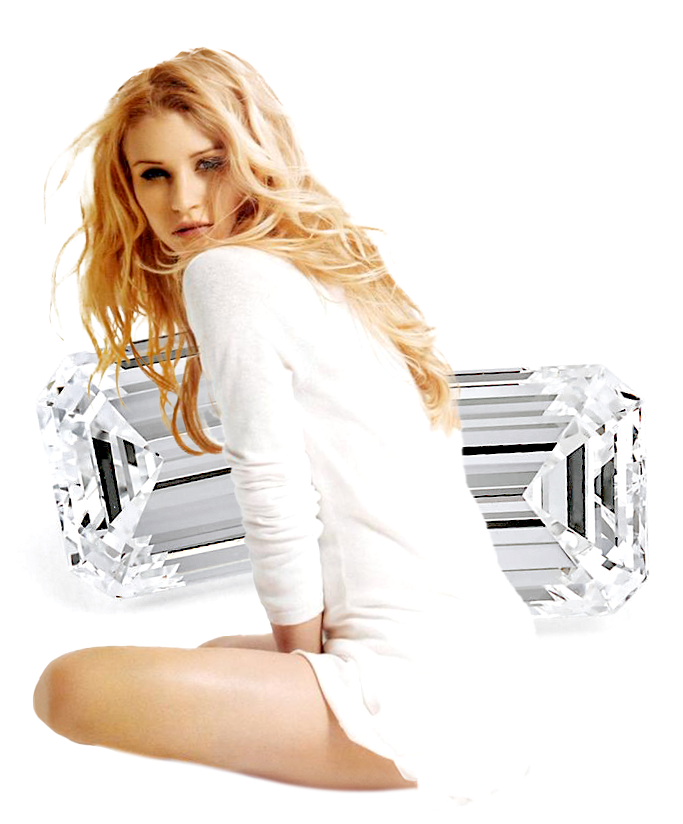
Engagement ring styles

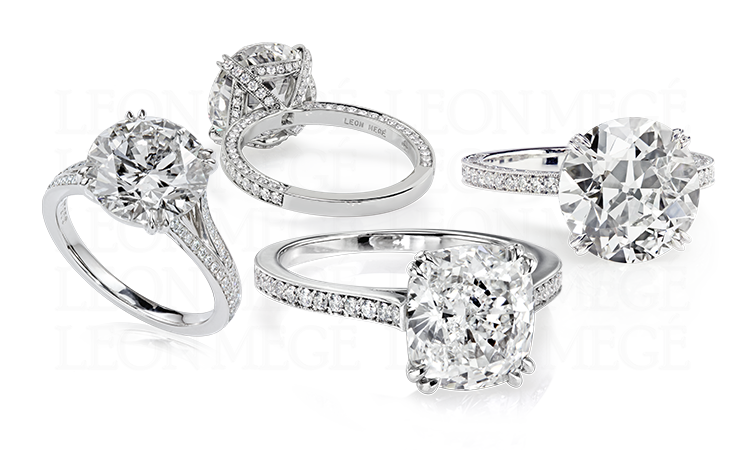
Pave solitaires 300-series
Series 300 Solitaire solitaire accented with traditional bright-cut pave infusing the boring plain metal with rigorous sparkle.
Pave solitaires 400-series
The legendary Series 400 engagement rings by Leon Mege put the universe’s sheen and splendor at your fingertips. All our Series 400 engagement rings are custom designed and could feature unique elements that are not the requisite parts of the design.
Series 400 engagement ring is a traditional solitaire accented with modern borderless pave.
Each style number in the series indicates how many rows of pave the ring has. The middle digit tells the number of rows on the ring’s head. The last digit tells the number of rows on the ring’s shank.
Halo rings 600-series
Both 600- and 800-series rings have a diamond halo that circles the center stone. On occasion, the halo can be set with colored gemstones. There are two main pave styles – modern and traditional.
Series 600 Halo rings with traditional pave, called bright-cut, bring a conservative style to the halo design. 600-series rings have an antique flair, often emphasized by millgrain. Diamonds in bright-cut pave are set single-file between two edges.
Halo rings 800-series
Series 800 Halo ring with modern, borderless pave.
Series 800 features modern pave styles, such as cut-down, V-cut, fishtail, etc. Each style differentiates the number of pave rows in the ring. The number in the middle is the number of rows in the halo. The last digit is the number of rows on the shank.
- 810 – single row halo with plain shank r7431
- 811 – single row halo with a single row on the shank r8129
- 813 – single row halo with a three-row shank r6577
- 821 – two-row halo, single-row shank r8221
Leon Mege 811 Halo style is our most popular halo engagement ring style.
Solitaires
A Solitaire is an engagement ring with a single stone floating over the finger with minimum attention to the mounting and all attention to the stone. Our 300- and 400-series engagement rings are solitaires with pave.
- Classic solitaire – Traditional ring style with a two-tiered basket and cathedral shank
- Modern solitaire – Contemporary ring style with a two-tiered basket and uniform shank
- Tulip solitaire, aka “Tiffany solitaire.” The crown-style mounting is typically outfitted with six prongs and is best suited for round stones.
Three- and five-stone rings
The elegant ring design, where stones are filed neatly in a row from East to West, can have many stones, but combinations of three and five are the most popular. Different shapes are synergized to produce a joined result greater than the sum.
The side stones‘ purpose is to draw attention to the center stone’s importance (physical or spiritual). They are mirror reflections of each other on both sides of the center. The sides are tilted down, shadowing the shank’s curve. Most side stones are colorless diamonds.
Cluster rings
A cluster ring occasionally called a “Cocktail ring” is a bouquet of shapes and, occasionally, colors that may or may not feature a keystone. Clusters built around a larger center are more traditional.
Those assembled from various shapes to form flower-like arrangements are more decorative and allow artistic freedom. Venerable brand owned by a company famous for its plastic wristwatches pioneered high-end cluster design far beyond the “leftover mix” typical in low-end jewelry. Rounds, marquises, and pears are the most popular shapes used in clusters.
